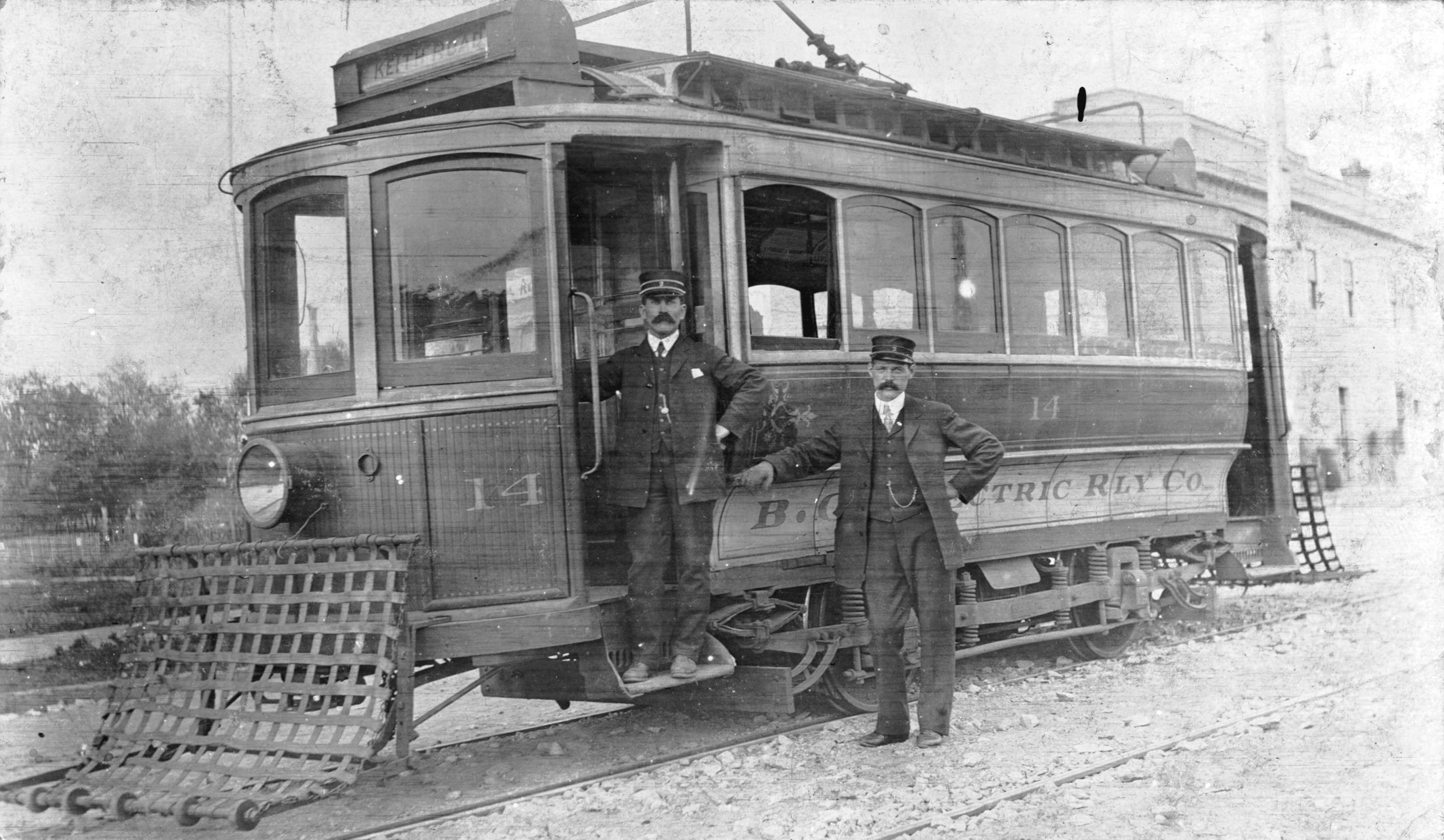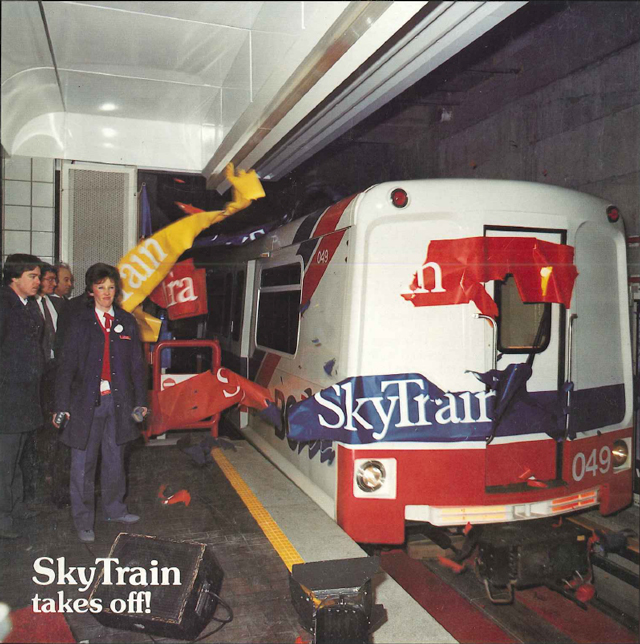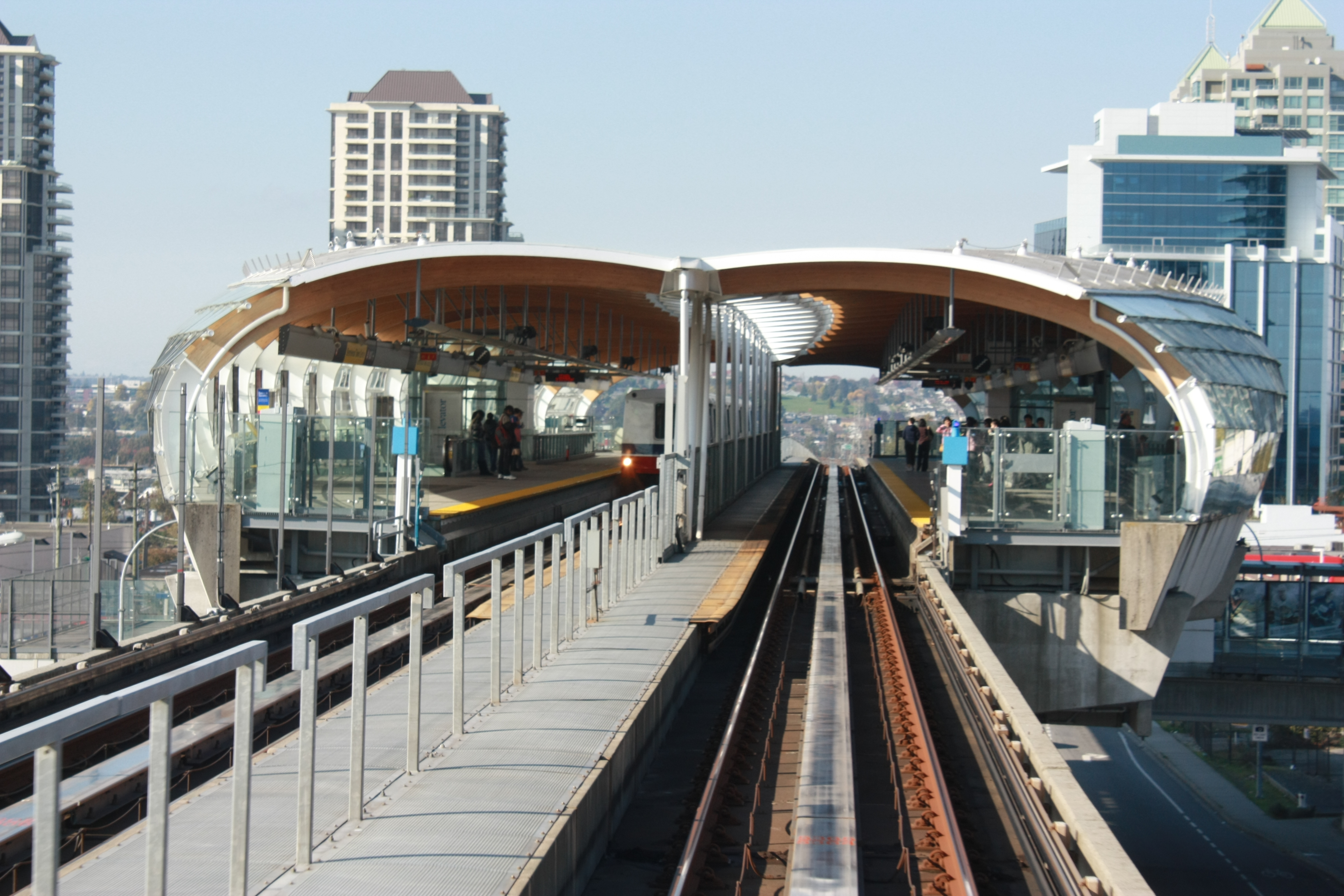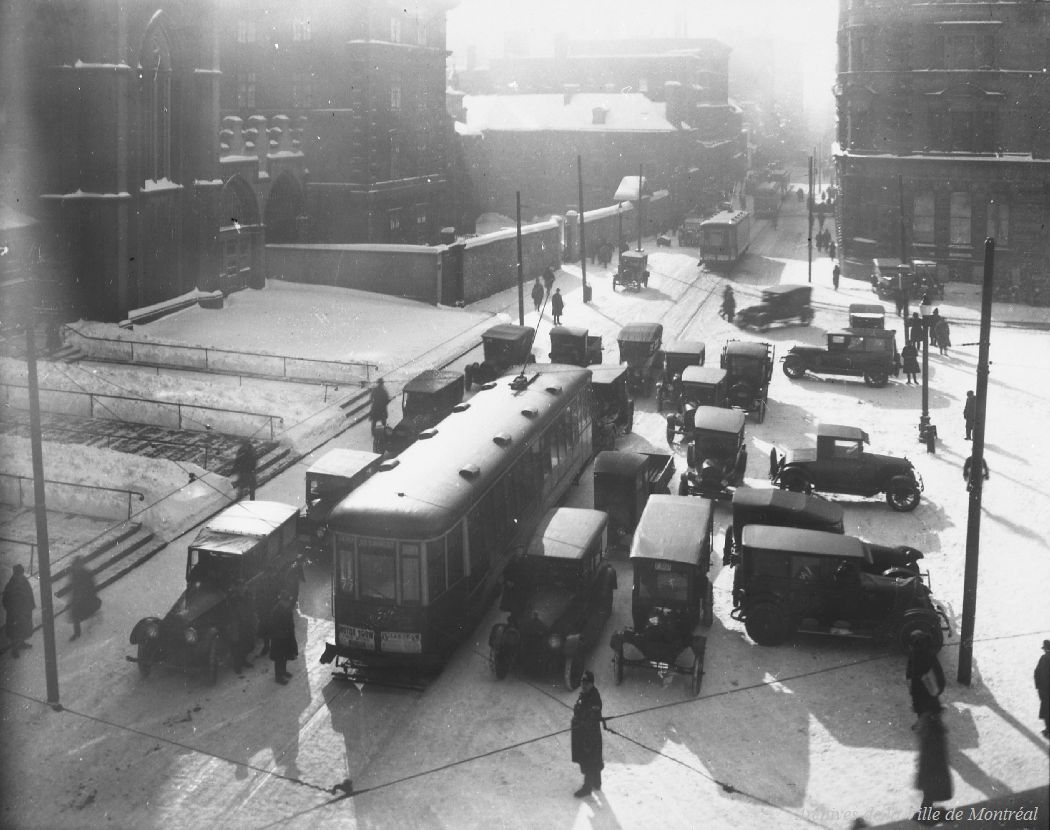The SkyTrain is the rapid transit rail system serving Metro Vancouver, British Columbia. It uses mostly Advanced Light Rapid Transit (ALRT) technology, an automated rail system that operates mainly on a raised guideway, although some sections run underground or at street level. Regular service began 3 January 1986. The SkyTrain’s opening coincided with Expo 86, the world’s fair hosted by Vancouver as part of its 100th anniversary celebrations. The system is run by TransLink, the provincial transit agency for the South Coast of British Columbia. It was the world’s first driverless urban rail system. Now, it is one of the longest fully automated rapid transit systems in the world. The SkyTrain has three lines connecting 53 stations in seven municipalities. In 2018, it had more than 495,000 boardings per weekday, on average.
History

Vancouver lost its public transit rail system when the British Columbia Electric Railway Company (BCER) ended rail service in favour of buses in the 1950s. Streetcar ridership had been declining for years due to the increasing number of buses and private cars. After decades of use, including years of depression and war with few upgrades and little maintenance, BCER ended streetcar service in 1955. Similarly, the interurban rail network that connected Vancouver to other Lower Mainland municipalities stopped running in 1958.
In Vancouver and other North American cities in the postwar years, urban planners preferred freeways as the solution to traffic problems. Vancouver’s freeway plans were never realized, however, due to public backlash, especially from affected communities. The only pieces of the freeway network that were built are the Georgia and Dunsmuir Viaducts connecting downtown to East Vancouver. These viaducts bridged an area where a section of False Creek and later rail yards once divided the city. They were completed in 1972, and in 2015, City Council voted to demolish them. (See also Hogan’s Alley.)
With more cars and no rail networks or freeways, Vancouver’s traffic problems worsened in the 1960s and 1970s. Many studies tackled the issue. Beginning with a 1968 report, they looked to rapid transit as the solution rather than increasing capacity for cars. A conventional heavy rail system like the subways or metros in other cities was proposed in one study, but ultimately rejected as too costly. Conventional rail would have too much capacity for Vancouver’s relatively low population density. It would also not address the needs of the suburbs. By 1975, planners considered Light Rapid Transit (LRT) to be the best option for Vancouver. LRT systems have lower operating and construction costs. They are similar to streetcars in that they run at street level, are slower and have less capacity than conventional subways.
In 1980, the provincial government decided on a new and relatively untested technology, Advanced Light Rail Transit (ALRT). After years of studies and discussions about the need for rapid transit, the motivation to build the SkyTrain was the world’s fair planned for Vancouver in 1986. The fair had a transportation theme that was later broadened to “World in Motion, World in Touch.” Originally to be called “Transpo 86,” it was renamed Expo 86, with the SkyTrain as its centrepiece. Tying the construction of the SkyTrain to a major international event made it a priority for all levels of government.

The political reason for choosing ALRT was that it was Canadian-owned technology. ALRT was developed by Urban Transportation Development Corporation (UTDC), an Ontario government crown agency set up after Toronto’s Spadina Expressway was cancelled. A small ALRT line was built in the Toronto suburb of Scarborough, but the technology had not been used on a city-wide scale. The federal government offered financial protection against the risks of the system being relatively untested. It hoped that showcasing the SkyTrain as fully functional and state-of-the-art would encourage non-Canadian cities to buy their own Canadian-made ALRT transit systems. An added advantage for British Columbia’s Social Credit government, which frequently clashed with unions, was that the driverless ALRT would add fewer unionized public sector workers than other options.
Network

The current SkyTrain network consists of the original Expo Line, the Millennium Line (along with its Evergreen Extension) and the Canada Line. The Broadway Extension of the Millennium Line is in the pre-construction stage.
Expo Line
The original SkyTrain line cost approximately $854 million. It ran 21.4 km through Vancouver, Burnaby and New Westminster, mostly on the old Central Park interurban line and downtown through the Dunsmuir Tunnel, an old rail tunnel built by the Canadian Pacific Railway in the 1930s. The line was extended in 1990 and again in 1994, adding 7 km and bringing the total number of stations to 20. The 1990 phase crossed the Fraser River into Surrey and included the construction of the SkyBridge, a dedicated 616 metre-long cable-stayed bridge. The line was named Expo Line in 2002 when the Millennium Line opened.
Millennium Line
The Millennium Line runs from VCC-Clark Station to Lafarge Lake-Douglas Station in Coquitlam. Until October 2016, it shared the Expo Line track from Waterfront Station to Columbia Station in New Westminster and looped back on a separate track to VCC-Clark Station. The 2016 changes, which reconfigured the network for the Evergreen Extension, reduced the route to east-west service between VCC-Clark and Lougheed Town Centre Station.
The Millennium Line began operations in 2002. By the next year, it had added 12 new stations from Commercial-Broadway Station to Sapperton Station in New Westminster. Critics called it the “SkyTrain to nowhere.” This was because it did not connect to Richmond or Coquitlam, where there was greater demand for rapid transit, and because the current terminus, VCC-Clark Station, sat empty until it became operational in 2006. VCC-Clark Station was chosen for its proximity to a proposed hi-tech park that was never built.
The opening of the Evergreen Extension in December 2016 added six stations and 11 km to the Millennium Line. The addition runs north-east of Lougheed Town Centre Station in Burnaby to serve Port Moody and Coquitlam. Two kilometres of the extension are underground and the rest runs on a raised guideway. One year after the Evergreen Extension opened, TransLink reported a 12 per cent increase in boardings on the Expo and Millennium lines. It also saw a spike of more than 25 per cent in weekday transit ridership in the Tri-Cities area (Coquitlam, Port Coquitlam and Port Moody).
Construction on yet another six-station addition to the Millennium Line, the Broadway Extension, is set to begin in fall 2020. Also called the Broadway Subway, the 5.7 km extension will begin aboveground at VCC-Clark Station and head underground, running beneath Broadway to Arbutus Street. A possible second phase would continue to the University of British Columbia (UBC). Transit demand along the corridor has increased dramatically since the City of Vancouver and TransLink first recommended extending the Millennium Line to central Broadway in 1999. Today, the Broadway Corridor between Commercial Drive and UBC in Point Grey is the busiest bus corridor in Canada and the US. On the average weekday, it carries 160,000 passengers, and the population along the route is only expected to grow.
Canada Line
The Canada Line connects Vancouver to Richmond. It opened in 2009, in the lead-up to the 2010 Winter Olympics. By 2010, it was carrying more than 100,000 passengers a day, exceeding ridership projections by three years. Although the Canada Line is also fully automated and driverless, it is a conventional heavy rail train and therefore not integrated with the other SkyTrain lines. It runs 19.2 km with 16 stations from Vancouver International Airport to Waterfront Station. At Waterfront, passengers can transfer to the Expo Line, the SeaBus ferry to cross Burrard Inlet, and the West Coast Express commuter train. Two bridges were built for the Canada Line. The North Arm Bridge connects Vancouver and Richmond. The Middle Arm Bridge crosses from Richmond to Sea Island where Vancouver International Airport is located.
Canada Line cars were built by Hyundai Rotem of South Korea. They use conventional electric motors and are more spacious than the Bombardier cars used on the other lines, but are noisier than ALRT cars. The Canada Line also differs from the other SkyTrain lines in that it is a public-private partnership — the largest in Canadian history. The line was built and is operated by InTransitBC, a joint venture company owned by engineering firm SNC-Lavalin, the Investment Management Corporation of BC, and investment firm Caisse de dépôt et placement du Québec. InTransitBC is independent from TransLink and is contracted to run the line for 35 years. Bombardier claims that it lost the bid because it proposed to tunnel beneath Cambie Street. InTransitBC instead used the much more disruptive but cheaper and quicker cut-and-cover method.
Design
ALRT was conceived as an Intermediate Capacity Transit System (ICTS). This is a middle option between heavy rail and Light Rapid Transit. (“Heavy” and “light” refer to carrying capacity, not train weight.) The capacity of ALRT cars is less than conventional trains, but ALRT can run more frequently during peak hours. During slower periods, capacity can be reduced by running fewer trains with fewer cars. This makes ALRT flexible and economical. Compared to LRT, the SkyTrain is faster and does not require any street-level crossings that would impact other traffic, but it costs significantly more to build.
ALRT uses Linear Induction Motors (LIM) and steerable axle trucks. LIMs have no moving parts and the wheels move with the curve of the tracks to minimize friction, noise, and wear-and-tear. LIMs use electrified magnets and a “third rail” on the track that pulls or slows the train. Compared to conventional trains propelled by the cars themselves, LIMs have superior braking and all-weather performance.
Expo Line stations were designed to be inexpensive to build and maintain. They use a “kit of parts” modular system with steel hoop trusses that hold up the station roofs and the concrete box beams carrying the tracks. Metal mesh was used instead of glass because it was cheaper and less vulnerable to vandals. In contrast, the Millennium Line stations were designed by different architects using a community consultation process in each neighbourhood. The architects agreed to incorporate standard features and use the same materials to give the stations a consistent look and to reduce costs.
Beginning with the Millennium Line, SkyTrain stations have incorporated crime prevention through environmental design (CPTED) principles. These including features such as good lighting and clear sightlines to allow commuters to better see and watch out for one another. Some Expo Line stations have been upgraded using CPTED principles. Several more are undergoing extensive upgrades to improve capacity, accessibility and CPTED security features. Security was further enhanced in 2005 when the SkyTrain became the only urban transportation system in Canada to introduce its own fully armed police force.
Canada Line stations are relatively uniform. They use glass and timber roof canopies and reinforced concrete for the platforms and track supports. Each station includes space for curated public art installations as part of TransLink’s public art program. Permanent art installations are included in Expo Line upgrades. TransLink partners with fine art institutions to curate its art spaces and has also directly funded public art on SkyTrain lines. As a result, TransLink has drawn criticism for prioritizing aesthetics while being unable to secure funding to improve and expand transit services.
Recent Debates
The SkyTrain network is a large, expensive infrastructure project funded by three levels of government. For these reasons, decisions about its expansion and funding tend to generate much debate.
A 2015 plebiscite (vote) seeking approval for a 0.5 per cent provincial sales tax increase to finance the Vancouver region’s share of its “10-Year Vision” plan failed to pass. (The 10-Year Vision plan represents billions of dollars worth of transportation upgrades, including the Broadway Extension.) Despite agreeing that transportation improvements were necessary, the “No” campaign emphasized TransLink’s overall performance and high executive salaries to win 62 per cent of the vote. Commentators criticized the plebiscite itself as an expensive political scheme by a government abandoning its responsibility for public transit to keep taxes low.
Nevertheless, Phase One of the 10-Year-Vision was launched in 2017. The federal and provincial governments have each promised at least $2 billion toward Phase Two, which includes construction of the Broadway Extension. The remaining funds will come from loans, financing, TransLink and regional government sources.
TransLink has proposed a 16.5 km extension of the Expo Line from King George Station in Surrey to Langley’s city centre. The elevated guideway would serve eight new stations along Fraser Highway. Surrey’s population is rapidly growing and it is the major hub south of the Fraser River. It is primarily a suburban and rural area with a low population density. It requires less transit capacity than Vancouver, but more than a bus system alone can handle.
As part of being fully automated, the SkyTrain was designed without fare collectors, turnstiles or gates. Periodic ticket checks were the only way to enforce fare payment. To reduce fare evasion, TransLink retrofitted stations with fare gates. In 2015, it introduced a new smartcard fare system called Compass for a total cost of $194.7 million, $23 million over the original budget. The new system was implemented two years late because of technical problems such as slow and inaccurate card readers. Compass replaced paper tickets and monthly passes on 1 January 2016.
The BC Liberal Party, which governed the province during the construction of the Canada Line and the Evergreen Extension, was criticized for its business relationship with Montreal-based SNC-Lavalin. A donor to the party, SNC-Lavalin led the consortium that was awarded the Evergreen Extension contract at the same time the RCMP was investigating the company for corruption in 2012–13. During the Evergreen project, there were issues with SNC-Lavalin’s Italian tunneling subcontractor, SELI, using temporary foreign workers who could not communicate with English-speaking workers and who lacked proper certification. Evergreen construction was plagued by health and safety problems. It was also delayed by sinkholes and other geological issues that slowed or halted tunnelling.
Impact
Like the streetcar and interurban systems before it, the SkyTrain has helped shape Vancouver’s development. Urban planners view rapid transit as a way to encourage development and densification in target areas. It can also help manage growth. For example, rapid transit offers the opportunity to create small commercial hubs throughout the city, reducing the need to travel long distances to shop and work. This relieves congestion on the city’s road and transit networks. But while the SkyTrain has spurred development in some neighbourhoods, it has failed to stimulate or revitalize others as expected.
Despite the touted advantages of ALRT and claims in the 1980s that it was the future of public transit, the technology was not adopted on a large scale. With few exceptions, other cities did not choose ALRT for their own rapid transit systems. Even one of the newer additions to the SkyTrain system, the Canada Line, uses conventional heavy rail technology. Nevertheless, the Canada Line is also fully automated, and driverless systems are increasingly popular for new rapid transit systems. Some experts argue that ALRT is simply a variation of a heavy rail system rather than a separate, intermediate category between light and heavy rail.
UTDC, the agency that developed ALRT, was acquired by Quebec-based Bombardier in 1991. Bombardier rebranded the technology Advanced Rapid Transit (ART), and then Innovia ART. It has continued to develop and produce Innovia ART, in part to service Vancouver’s SkyTrain, but also for smaller systems in other cities, such as those at airports.
Expo 86 was a milestone event in Vancouver’s history and the SkyTrain is its most significant and enduring legacy. Ridership on the three existing lines averaged more than 495,000 boardings per weekday in 2018. With the SkyTrain’s expansion and Metro Vancouver’s growing population — expected to increase by more than one million people by 2040 — ridership will undoubtedly skyrocket. In the foreseeable future, as Vancouver increasingly strives towards environmental sustainability, density and livability, the SkyTrain’s importance in the region’s transportation infrastructure will only grow.

 Share on Facebook
Share on Facebook Share on X
Share on X Share by Email
Share by Email Share on Google Classroom
Share on Google Classroom

















